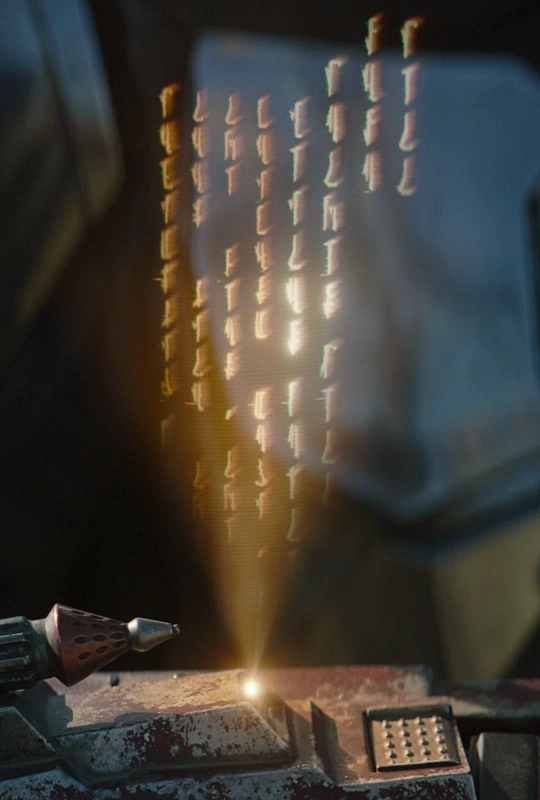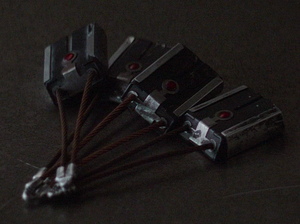Chain code
Contributors to Wookieepedia
 Article Images
Article Images
If anybody runs my chain code, I'll rot in a cell for the rest of my life.Carasynthia Dune, to Din Djarin
A chain code, also known as a chaincode, was a type of identification marker that contained biographical information on an individual. Attuned to a subject's specific bio-metrics, these markers cataloged certain features of a person and their history. They were first introduced by the fledgling Galactic Empire shortly after the Clone Wars, and continued to be used by the New Republic. Chain codes were also commonly used by bounty hunters, who used the markers in conjunction with devices known as tracking fobs to locate their targets.
What's the chain code?"
"We can only provide the last four digits."
"Their age? That's all you can give me?Din Djarin and an Imperial client
A type of identification marker,[6] chain codes identified[7] and described[6] specific bio-metric details of an individual.[7] They also described biographical information relating to the individual,[6] including the subject's age,[4] family history,[8] and criminal record.[5] The chain code was made up of several numbers that displayed said information, with the final four digits signifying the subject's age.[4] Since governments like the New Republic were known to run an individual's chain code upon securing passage on registered starships, it was practice among criminals to lay low in order to avoid having the details of their codes shared.[5]

The information within these markers was used by the enforcers of the Bounty Hunters' Guild, who were given access to their targets' codes upon accepting assignments. Hunters made use of devices known as tracking fobs, short-range sensors that were attuned to a code's specifics[1] and data. A tracking fob allowed a hunter to zero in on a bounty and confirm the target's identity.[6] It took an experienced hunter capable of networking for information and stalking prey to fully utilize a tracking fob.[9] After the hunter had obtained the target, dead or alive, Guild operatives would run a check on the body to ensure that it matched to the information included within the chain code.[1]
In practice, the use of chain codes on a galaxy-wide scale, as they were implemented by the Galactic Empire, enabled the reigning government to build up a database of everyone in the galaxy. In order to register citizens within the chain code network, public shuttle transport and conversion of old Galactic Republic credits into Imperial currency was locked behind a chain code, forcing people to register.[2] During its early days, these codes were challenging, but not impossible, to forge, but this was made more difficult with the passage of time.[9] Despite the fall of the Empire, the New Republic,[5] the Bounty Hunters' Guild, and Gideon's Imperial remnant continued to make use of chain codes.[4] As such, the Empire's usage of chain codes continued to have an effect into the New Republic Era.[6]
It's ironic. Clones wanted names instead of numbers, yet now people are signing up to be given numbers."
"It's ingenious. You could create a database to identify anyone in the galaxy.Echo and Tech discuss the Empire's implementation of chain codes

Chain codes were in usage as a form of identification during the Imperial Era. During the early days of the Galactic Empire[2] in 19 BBY,[10] citizens of the newly formed regime were required to register for a chain code in order to book passage off world or to convert their Republic credits into Imperial credits.[2] Many went along with it not realizing that the Empire was cataloguing its own population in order to track their movements, their background, and their everyday activities. Many believed that such information was safe in the hands of their new benevolent government, but some would come to regret that when it was used against them in various trumped-up legal charges.[11] Due to the new rule, clone deserter Cut Lawquane and his family had to receive help from Clone Force 99 to forge chain codes for them so they could book passage off of Saleucami.[2] Clone Force 99 would later forge multiple chain codes to trade with the Vanguard Axis only for the deal to fall through as a result of an altercation with the Wookiee Padawan Gungi.[12]
With the passage of time, chain codes became more difficult to forge.[9] Around 16 BBY,[13] the chain code of bounty hunter Boba Fett was encoded into a set of Mandalorian armor formerly worn by Boba's father, Jango Fett. This code was written in the Mando'a script and contained information on not only the Fetts but Jango's mentor as well.[8] During the Imperial reign, Bothans forged false chain codes that were implanted into Aqualish by Nautolan doctors. There were huge empty strings of chain codes within Imperial administration files. The only information attached to these files explained that the chain codes were initially attached to an individual, and then were later rendered obsolete with the tag "subject purged, code redundant."[11]

Despite the practice being rolled out by the Empire,[2] the New Republic continued to make use of chain codes during its reign.[5] In 9 ABY,[14] the Mandalorian bounty hunter Din Djarin was hired by an Imperial remnant to acquire the Force-sensitive infant Grogu. The chain code provided to Djarin was fractured, only pertaining to the child's age, though the hunter located the infant on the planet Arvala-7 after also being given Grogu's last known positioning.[4] Later, Djarin's ally, Magistrate Greef Karga, was prevented from entering a city on the planet Nevarro without first presenting his chain code to a persistent scout trooper. Karga turned over a small card, which the scout trooper scanned with a rod-like device.[5]
Cara Dune, a former shock trooper of the Alliance to Restore the Republic, committed several crimes following the Galactic Civil War that carried life sentences should she be apprehended by the New Republic. Knowing the consequences of having her chain code run through official channels, she resolved to lay low on Outer Rim worlds, like Sorgan to avoid prosecution.[5] After liberating Nevarro of Imperials with Djarin and Karga, the magistrate offered Dune a position as his enforcer, promising to take care of whatever "clerical concerns" she had regarding her chain code.[15] After taking up Karga's offer, Dune went on to become a deputized marshal of the New Republic.[8]
Many years after his chain code was first encoded into his armor, the mercenary Boba Fett sought to reclaim his father's equipment, which was by that point in the hands of Din Djarin. Djarin was strongly opposed to returning the armor to Fett, as the Mandalorian Creed dictated that it rightfully belonged to the Mandalorian people. In order to convince the hunter that his claim to the armor was justified, Fett showed his chain code to Djarin on the planet Tython, proving to the man that Fett was of Mandalorian heritage.[8]
Chain codes were first mentioned within the first episode of the The Mandalorian, a Disney+ television series created by Jon Favreau.[4] The codes are mentioned several times throughout the first season, later appearing onscreen through a hologram of Boba Fett's code in the sixth episode of the show's second season.[8]